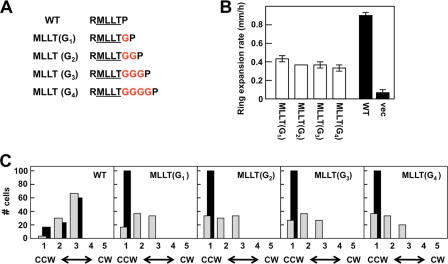FIG. 2.
Effects of inserting multiple Gly residues between Thr-218 and Pro-219 of AS1 [MLLT(Gn) mutants] on the signaling state of Tar. (A) Illustration of the MLLT(Gn) series of mutants. Inserted Gly residues are shown in red. (B) Aspartate chemotaxis ring expansion rates, measured in mm/h, for VB13 cells expressing wild-type or mutant [the MLLT(Gn) series] receptors. The error bars represent the standard errors of the mean, with n = 3. (C) Rotational biases of VB13 and HCB436 cells expressing wild-type or mutant receptors. The cells were placed into one of five categories on the basis of their CW/CCW rotational ratios, from left to right: 1, CCW locked; 2, CCW biased; 3, frequently reversing; 4, CW biased; and 5, CW locked. One hundred cells were analyzed for each mutant. WT, wild type.

